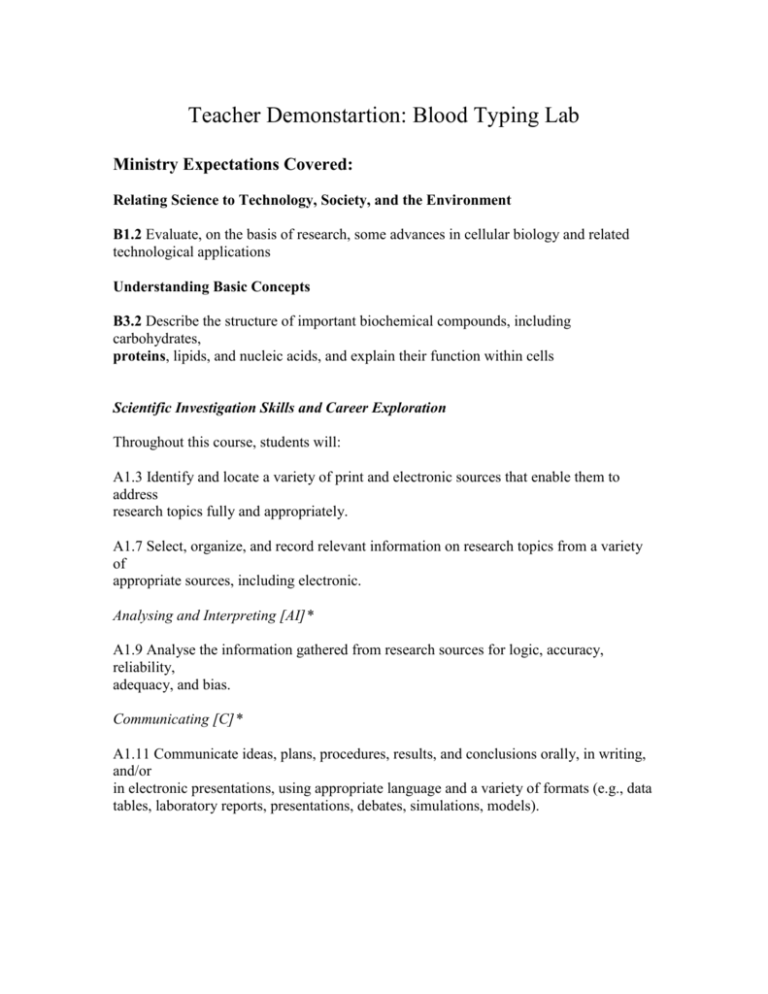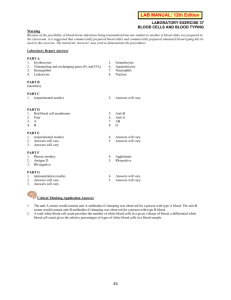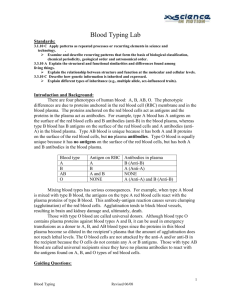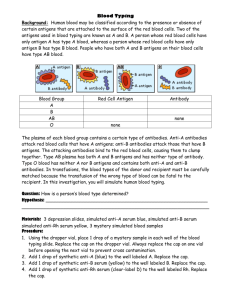Teacher Demonstration-Blood Typing Lab
advertisement

Teacher Demonstartion: Blood Typing Lab Ministry Expectations Covered: Relating Science to Technology, Society, and the Environment B1.2 Evaluate, on the basis of research, some advances in cellular biology and related technological applications Understanding Basic Concepts B3.2 Describe the structure of important biochemical compounds, including carbohydrates, proteins, lipids, and nucleic acids, and explain their function within cells Scientific Investigation Skills and Career Exploration Throughout this course, students will: A1.3 Identify and locate a variety of print and electronic sources that enable them to address research topics fully and appropriately. A1.7 Select, organize, and record relevant information on research topics from a variety of appropriate sources, including electronic. Analysing and Interpreting [AI]* A1.9 Analyse the information gathered from research sources for logic, accuracy, reliability, adequacy, and bias. Communicating [C]* A1.11 Communicate ideas, plans, procedures, results, and conclusions orally, in writing, and/or in electronic presentations, using appropriate language and a variety of formats (e.g., data tables, laboratory reports, presentations, debates, simulations, models). Introduction: There are 4 types of human blood: A, B, AB, O. The difference is due to proteins found both on the red blood cells and in the blood plasma. The proteins on the red blood cells act as antigens and the proteins in the plasma act as antibodies. Type A blood has A antigens on the surface of the red blood cells and B antibodies (anti-B) in the blood plasma. Type B blood has B antigens on the surface of the red blood cells and A antibodies (anti-A) in the blood plasma. Type AB blood has both A and B antigens on the surface of the red blood cells, but no plasma antibodies. Type O blood has no antigens on the surface of the red blood cells, and has both A and B antibodies in the blood plasma. Mixing blood types has serious consequences. For example, when type A blood is mixed with type B blood, the antigens on the type A red blood cells react with the serum antibodies of type B blood. This antibody antigen reaction causes severe clumping (agglutination) of the red blood cells. This tends to block blood vessels, resulting in brain and kidney damage and, ultimately, death. Those with type O blood are called universal donors. Although blood type O contains plasma antibodies against blood types A and B, it can sometimes be used in emergency transfusions as a donor to these blood types since the antibodies in this blood plasma become so diluted in the recipient’s plasma that the amount of clumping does not reach lethal levels. The O blood cells are not attacked by the anti-A and/or anti-B in the recipient because the O cells do not contain any A or B antigens. Those with type AB blood are called universal recipients since they have no plasma antibodies to react with the antigens found on A, B, and O types of red blood cells. Each blood type is also grouped by its Rhesus factor, or Rh factor. Rhesus refers to another type of antigen, or protein, on the surface of red blood cells. The name Rhesus comes from Rhesus monkeys, in which the protein was discovered. Blood is either Rh positive (Rh+) or Rh negative (Rh-). The “D” antigen on red blood cells denotes Rh Positive blood and the absence of the “D” antigen denotes Rh Negative blood. 85% of Canadians are Rh Positive and 15% are Rh Negative. The combination of your blood group and Rh factor gives your full blood type. Our knowledge about binding properties of antigens and antibodies has enabled us to identify and purify proteins and study protein size, make-up and location through the use of western blotting and immunohistochemical/immunofluorescent techniques. If you are interested in entering the medical profession as either a medical lab technician, a research assistant, a researcher, a doctor or a nurse – this practical application of protein knowledge becomes important. ** Note: A potential common misconception: students may get confused with the issue of whether your blood type refers to the antigens or the antibodies you carry – so type A could be thought of as a person that has anti-A antibodies versus A antigens. Another source of confusion is in regards to which are on the blood cell and which are in the plasma: the antigens or the antibodies? Antibodies are normally not static, rather moving, traveling, versus antigens that are generally static, attached. Learning Goals: At the end of the lab, students will be able to: 1. Identify and describe the various blood types 2. Describe a test to determine the blood type from their sample patient 3. Discuss the different blood types according to antigens and antibodies present 4. Analyze the “samples” population for frequency of blood type in a population 5. Understand the role biochemical applications play in everyday life. (There is an opportunity here to use the demo as an anchor when later introducing the protein section of biochemistry, by highlighting the protein nature and makeup of antibodies and antigens). Safety notes: Human blood is not used for this lab, hence no special biohazard safety precautions are necessary. Regular lab rules around handling equipment with care, avoiding and quickly dealing with spills and broken glass should be followed. Materials: 1 petri dish with lid or multiwell dish stir sticks 1 vial anti-A sharpie disposable pipettes with bulb 2 vials unknown sample 1 vial anti-B Procedure: 1. Mark the underside of one half of the petri dish “anti-A” and mark the other part “anti-B”. 2. Add 1 drop of the unknown sample onto side 1 and 1 drop onto side 2. 3. Add 1 drop of anti-A onto side 1 and mix with sample. Dispose of the pipette. 4. Add 1 drop of anti-B onto side 2 and mix with sample. Dispose of the pipette. 5. Check each side for agglutination and record below for positive (agglutination) or negative (no agglutination) reactions. Determine the blood type of your unknown sample. ** Note: Could also use a Gizmo/SmartBoard or other Simulation-type lab program instead of performing lab Unknown #1 Anti –A in side 1 Anti –B in side 2 reaction (+ or -) Expect reaction for type A and AB. Expect reaction for type B and AB. Unknown #2 Anti-A in side 1 Anti-B in side 2 Same as above. Blood type of unknown # 1 is ______. Blood type of unknown # 2 is ______. If type A, only reacts on side 1. If type B, only reacts on side 2. If type AB, reacts on both sides 1 and 2. If type O, shows no reaction on either side. Analysis/Conclusion: 1. Record known blood types of students in class on the board or on Google Docs class site. When all of the results are in, calculate the % of each blood type sampled/known: A blood = B blood = AB blood = O blood = % % % % 2. Make a graph of the class results. Dependent on class results, but should be close to Canadian average breakdown – see chart below Based on #1 – bar graph/histogram of blood types and percentages 3. What type of blood could your Unknown #1 patient safely get a transfusion from? What type of blood transfusion would kill your patient? Why? Again this will depend on sample used, so if blood type O, can get only from O, any others could kill them, because have both anti-A and anti-B in plasma, but no surface antigens. Blood type O is also a safe donor for any other blood-type. Homework Fun/Entry Ticket: 1. Fill in the chart below using various internet resources (I.e. Canadian blood services). Will probably use Canadian Blood Services or other Canadian Site 2. How do these results compare to class results? Should be similar. 3. Do all countries around the world have a similar breakdown of blood types (i.e: similar percentage of each type)? No – will find some that do not have a majority of type O, rather equal distribution or more of another type. Blood type Percent of Canadians with this type Who can receive this type O+ 39% O+, A+, B+, AB+ O– 7 All blood types A+ 36 A+, AB+ A– 6 A+, A–, AB+, AB– B+ 7.6 B+, AB+ B– 1.4 B+, B–, AB+, AB– AB+ 2.5 AB+ AB– .5 AB+, AB– 4. Why does knowing whether a woman is Rh+ or Rh- become important in pregnancy? Hemolytic disease of the newborn (HDN) – an Rh- mother could form antibodies against an Rh+ fetus, resulting in a severe blood agglutination reaction and the baby’s death. Did You Know? Blood type is inherited, just like eye color. Certain blood types are more common in certain countries. In China, over 99% of the population has Rh+ blood. Different kinds of animals have different kinds of blood. Dogs have 4 blood types; cats have 11; cows have about 800. Some people think blood type tells about personality. Legend has it that Type A is calm and trustworthy; Type B is creative and excitable; Type AB is thoughtful and emotional; and Type O is a confident leader. In Japan, the idea of blood type as personality type is so popular that Japanese ask “What's your blood type?” about as often as Americans ask “What's your sign?” There have been many books published on special “blood-type diets”, where authors with or without medical/scientific credentials propose specific diets that work to keep people healthy and fit based on their blood type!





